Nakshatra
Nakshatra (Sanskrit: नक्षत्र, IAST: Nakṣatra) is the term for lunar mansion in Hindu astrology and Indian Astronomy. A nakshatra is one of 28 (sometimes also 27) sectors along the ecliptic. Their names are related to a prominent star or asterisms in or near the respective sectors.
| Nakshatras |
|---|
|
The starting point for the nakshatras according to Vedas is "Kritika" (it has been argued because the Pleiades may have started the year at the time the Vedas were compiled, presumably at the vernal equinox), but, in more recent compilations, the start of the nakshatras list is the point on the ecliptic directly opposite to the star Spica called Chitrā in Sanskrit, which would be Ashvinī, an asterism that is part of the modern constellation Aries, and these compilations therefore may have been compiled during the centuries when the sun was passing through the area of the constellation Aries at the time of the vernal equinox. This version may have been called Meshādi or the "start of Aries".[1]
The first astronomical text that lists them is the Vedanga Jyotisha.[2]
In classical Hindu scriptures (Mahabharata, Harivamsa), the creation of the nakshatras is attributed to Daksha. They are personified as daughters of Daksha and as wives of Chandra known as the Moon God (who reluctantly married the 26 other nakshatra's on Daksha's request even though he was only interested to marry Rohini), or alternatively the daughters of Kashyapa, the brother of Daksha.
In the Atharvaveda
In the Atharvaveda (Shaunakiya recension, hymn 19.7) a list of 28 stars or asterisms is given, many of them corresponding to the later nakshatras:[3]
- Kṛttikā (the Pleiades)
- Rohinī (Aldebaran)
- Mrigashīrsha
- Ārdrā (Betelgeuse)
- Punarvasu
- Pushya
- Asleshā
- Maghā (Regulus)
- Purva phalguni
- Uttara phalguni (Denebola)
- Hasta
- Chitrā (Spica)
- Svāti (Arcturus)
- Vishākhā
- Anurādhā
- Jyeshthā
- Mūla
- Purva ashadha
- Uttara ashadha
- Shravana
- Dhanishta
- Satabhishak (Sadachbia)
- Purva bhadrapada
- Uttara bhadrapada
- Revati
- Ashvini
- Bharani
This 27-day time cycle has been taken to mean a particular group of stars. The relationship to the stars really has to do with the periodicity with which the Moon travels over time and through space past the field of the specific stars called nakshatras. Hence, the stars are more like numbers on a clock through which the hands of time pass (the moon). This concept is also described by Dr. Jessie Mercay in her research on Surya Siddhanta.[4]
List of Nakshatras
In Hindu astronomy, there was an older tradition of 28 Nakshatras which were used as celestial markers in the heavens. When these were mapped into equal divisions of the ecliptic, a division of 27 portions was adopted since that resulted in a cleaner definition of each portion (i.e. segment) subtending 13° 20′ (as opposed to 12° 51 3⁄7′ in the case of 28 segments). In the process, the Nakshatra Abhijit was left out without a portion.[5]:179 The Surya Siddhantha concisely specifies the coordinates of the twenty seven Nakshatras.[5]:211
It is noted above that with the older tradition of 28 Nakshatras each equal segment would subtend 12.85 degrees or 12° 51′. But the 28 Nakshatra were chosen at a time when the Vedic month was recognised as having exactly 30 days. In India and China the original 28 lunar mansions were not equal. Weixing Nui provides a list of the extent of the original 28 Nakshatras expressed in Muhurtas (with one Muhurta = 48 minutes of arc). Hindu texts note there were 16 Nakshatras of 30 Muhurtas, 6 of 45 Muhurtas, 5 of 15 Muhurtas and one of 6 Muhurtas.
The 28 mansions of the 360° lunar zodiac total 831 Muhurtas or 27.7 days. This is sometimes described as an inaccurate estimate of our modern sidereal period of 27.3 days, but using the ancient Indian calendar with Vedic months of 30 days and a daily movement of the Moon of 13 degrees, this early designation of a sidereal month of 831 Muhurtas or 27.7 days is very precise.[lower-alpha 1][6] Later some Indian savants dropped the Nakshatra named Abhijit to reduce the number of divisions to 27, but the Chinese retained all of their original 28 lunar mansions. These were grouped into four equal quarters which would have been fundamentally disrupted if it had been decided to reduce the number of divisions to 27.
Irrespective of the reason why ancient early Indian astronomers followed a Vedic calendar of exactly 12 months of 30 days it was this calendar and not a modern calendar of 365 days that they used for the astronomical calculations for the number of days taken for the Moon to complete one sidereal cycle of 360°. This is why initially they named 28 Nakshatras on their lunar zodiac.[7]
The following list of nakshatras gives the corresponding regions of sky, per Basham (1954).[8]
| No. | Name | Associated stars | Description | Image |
|---|---|---|---|---|
| 1 | Ashwini |
β and γ Arietis |
|
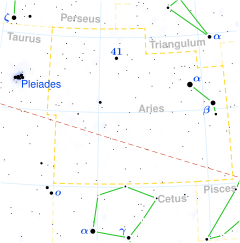 |
| 2 | Bharani "the bearer" |
35, 39, and 41 Arietis |  | |
| 3 | Krittika an old name of the Pleiades; personified as the nurses of Kārttikeya, a son of Shiva. |
Pleiades | 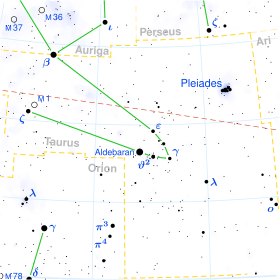 | |
| 4 | Rohini "the red one", a name of Aldebaran. Also known as brāhmī |
Aldebaran |  | |
| 5 | Mrigashīra "the deer's head". Also known as āgrahāyaṇī |
λ, φ Orionis | 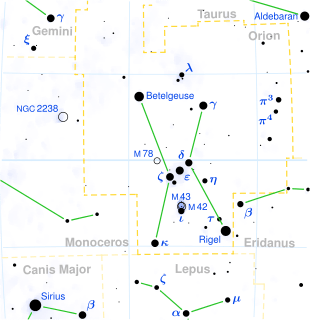 | |
| 6 | Ardra "the moist one" |
Betelgeuse |  | |
| 7 | Punarvasu (dual) "the two restorers of goods", also known as yamakau "the two chariots" |
Castor and Pollux | 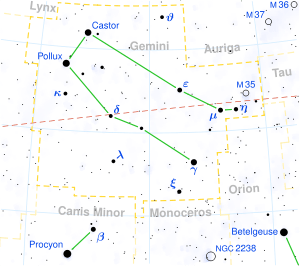 | |
| 8 | Pushya/Tishya "the nourisher", also known as sidhya or tiṣya |
γ, δ and θ Cancri | 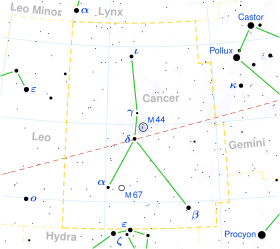 | |
| 9 | Ashleshā "the embrace" |
δ, ε, η, ρ, and σ Hydrae | 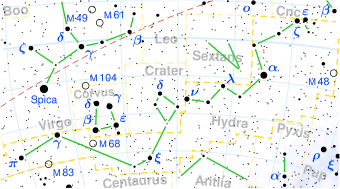 | |
| 10 | Maghā "the bountiful" |
Regulus | 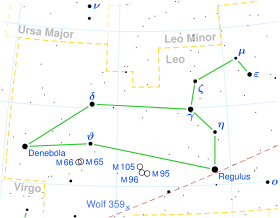 | |
| 11 | Pūrva Phalgunī "first reddish one" |
δ and θ Leonis |  | |
| 12 | Uttara Phalgunī "second reddish one" |
Denebola |  | |
| 13 | Hasta "the hand" |
α, β, γ, δ and ε Corvi | 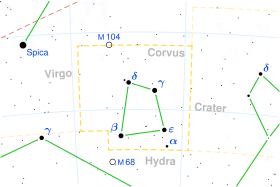 | |
| 14 | Chitra "the bright one", a name of Spica |
Spica |
|
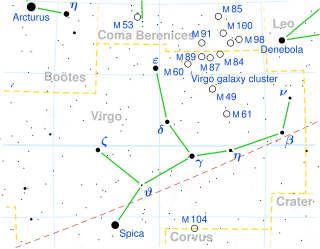 |
| 15 | Swāti "Su-Ati (sanskrit) Very good" name of Arcturus |
Arcturus | 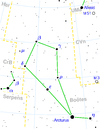 | |
| 16 | Visakha "forked, having branches"; also known as rādhā "the gift" |
α, β, γ and ι Librae | 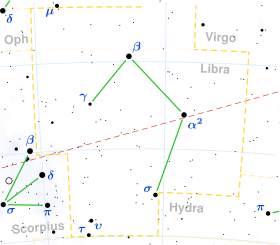 | |
| 17 | Anuradha "following rādhā" |
β, δ and π Scorpionis | 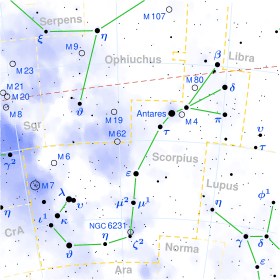 | |
| 18 | Jyeshtha "the eldest, most excellent" |
α, σ, and τ Scorpionis |  | |
| 19 | Mula "the root" |
ε, ζ, η, θ, ι, κ, λ, μ and ν Scorpionis |  | |
| 20 | Purva Ashadha "first of the aṣāḍhā", aṣāḍhā "the invincible one" being the name of a constellation |
δ and ε Sagittarii | 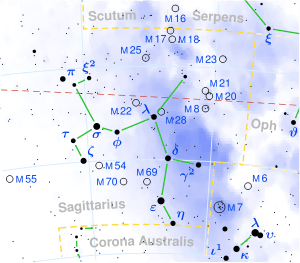 | |
| 21 | Uttara Ashadha "second of the aṣāḍhā" |
ζ and σ Sagittarii |
|
 |
| 22 | Abhijit |
ζ and σ Lyra |
|
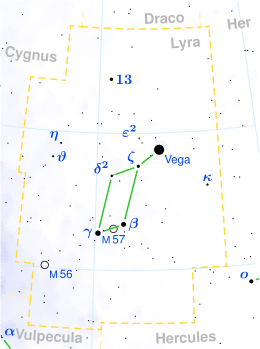 |
| 23 | Shravana |
α, β and γ Aquilae | 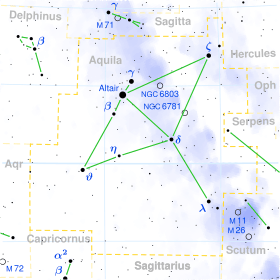 | |
| 24 | Dhanishta "most famous", also Shravishthā "swiftest" |
α to δ Delphini | 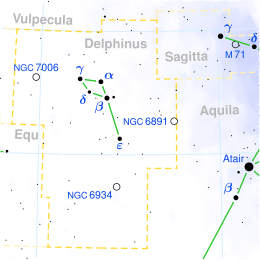 | |
| 25 | Shatabhisha "Comprising a hundred physicians" |
Sadachbia | 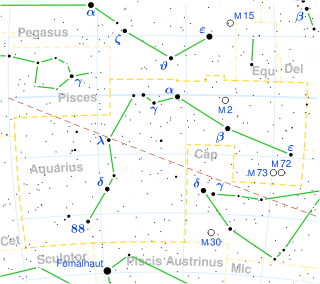 | |
| 26 | Purva Bhadrapada "the first of the blessed feet" |
α and β Pegasi |
|
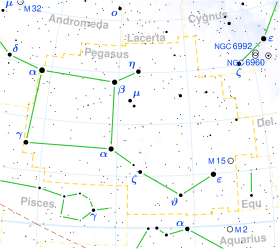 |
| 27 | Uttara Bhadrapada "the second of the blessed feet" |
γ Pegasi and α Andromedae | .png) | |
| 28 | Revati "prosperous" |
ζ Piscium | 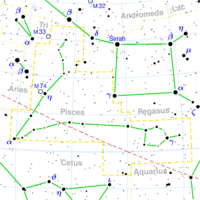 |
Padas (quarters)
Each of the 27 Nakshatras cover 13° 20’ of the ecliptic each. Each Nakshatra is also divided into quarters or padas of 3° 20’, and the below table lists the appropriate starting sound to name the child. The 27 nakshatras, each with 4 padas, give 108, which is the number of beads in a japa mala, representing all the elements (ansh) of Vishnu:
| # | Name | Pada 1 | Pada 2 | Pada 3 | Pada 4 | Vimsottari Lord | Ruling Deity |
|---|---|---|---|---|---|---|---|
| 1 | Aśvini (अश्विनि) | चु Chu | चे Che | चो Cho | ला La | Ketu | Aswini Kumara |
| 2 | Bharaṇī (भरणी) | ली Li | लू Lu | ले Le | लो Lo | Venus | Yama |
| 3 | Kṛttikā (कृत्तिका) | अ A | ई I | उ U | ए E | Sun | Agni |
| 4 | Rohiṇī (रोहिणी) | ओ O | वा Va/Ba | वी Vi/Bi | वु Vu/Bu | Moon | Brahma |
| 5 | Mṛgaśīrṣā(म्रृगशीर्षा) | वे Ve/Be | वो Vo/Bo | का Ka | की Ke | Mars | Moon |
| 6 | Ārdrā (आर्द्रा) | कु Ku | घ Gha | ङ Ng/Na | छ Chha | Rahu | Shiva |
| 7 | Punarvasu (पुनर्वसु) | के Ke | को Ko | हा Ha | ही Hi | Jupiter | Aditi |
| 8 | Puṣya (पुष्य) | हु Hu | हे He | हो Ho | ड Da | Saturn | Jupiter |
| 9 | Āśleṣā (आश्लेषा) | डी Di | डू Du | डे De | डो Do | Mercury | Rahu |
| 10 | Maghā (मघा) | मा Ma | मी Mi | मू Mu | मे Me | Ketu | Pitr |
| 11 | Pūrva or Pūrva Phālgunī (पूर्व फाल्गुनी) | नो Mo | टा Ta | टी Ti | टू Tu | Venus | Bhaga |
| 12 | Uttara or Uttara Phālgunī (उत्तर फाल्गुनी) | टे Te | टो To | पा Pa | पी Pi | Sun | Sun |
| 13 | Hasta (हस्त) | पू Pu | ष Sha | ण Na | ठ Tha | Moon | Savitr |
| 14 | Chitrā (चित्रा) | पे Pe | पो Po | रा Ra | री Ri | Mars | Vishwakarma |
| 15 | Svāti (स्वाति) | रू Ru | रे Re | रो Ro | ता Ta | Rahu | Vaayu |
| 16 | Viśākhā (विशाखा) | ती Ti | तू Tu | ते Te | तो To | Jupiter | Indra Agni |
| 17 | Anurādhā (अनुराधा) | ना Na | नी Ni | नू Nu | ने Ne | Saturn | Mitra |
| 18 | Jyeṣṭhā (ज्येष्ठा) | नो No | या Ya | यी Yi | यू Yu | Mercury | Indra |
| 19 | Mūla (मूल) | ये Ye | यो Yo | भा Bha | भी Bhi | Ketu | Varuna, Nirriti |
| 20 | Pūrva Aṣāḍhā (पूर्वाषाढ़ा) | भू Bhu | धा Dha | फा Bha/Pha | ढा Dha | Venus | Apah |
| 21 | Uttara Aṣāḍhā (उत्तराषाढ़ा) | भे Bhe | भो Bho | जा Ja | जी Ji | Sun | Brahma |
| 22 | Śrāvaṇa (श्रावण) | खी Ju/Khi | खू Je/Khu | खे Jo/Khe | खो Gha/Kho | Moon | Vishnu |
| 23 | Śrāviṣṭhā (श्रविष्ठा) or Dhaniṣṭhā (धनिष्ठा) | गा Ga | गी Gi | गु Gu | गे Ge | Mars | Vasu |
| 24 | Śatabhiṣā (शतभिषा)or Śatataraka | गो Go | सा Sa | सी Si | सू Su | Rahu | Varuna |
| 25 | Pūrva Bhādrapadā (पूर्वभाद्रपदा) | से Se | सो So | दा Da | दी Di | Jupiter | Aja Ek Pada |
| 26 | Uttara Bhādrapadā (उत्तरभाद्रपदा) | दू Du | थ Tha | झ Jha | ञ Da/Tra | Saturn | Ahirbudhanya |
| 27 | Revati (रेवती) | दे De | दो Do | च Cha | ची Chi | Mercury | Pooshan |
See also
- Atmakaraka
- Navagraha
- Panchangam
- Gandanta
- Chinese constellations
- Twenty-eight mansions
- Decans (Egyptian)
- Saptarishi
Notes
- The exact figure should be nearer 27.692308 but 27.7 is near enough.
References
- The Radiant Words of Love & Wisdom By Vashisht Vaid, 2012
- "Nakshatras and Upanakshatras". vedanet.com. American Institute of Vedic Studies. June 13, 2012. Archived from the original on March 22, 2015.
-
trans. Ralph T. H. Griffith, Hymns of the Atharva Veda, 1895.
Original text via GRETIL Archived 2012-02-02 at the Wayback Machine from Gli inni dell’ Atharvaveda (Saunaka), trasliterazione a cura di Chatia Orlandi, Pisa 1991, collated with the ed. R. Roth and W.D. Whitney: Atharva Veda Sanhita, Berlin 1856.
- citrā́ṇi sākáṃ diví rocanā́ni sarīsr̥pā́ṇi bhúvane javā́ni | turmíśaṃ sumatím ichámāno áhāni gīrbhíḥ saparyāmi nā́kam
- suhávam agne kŕ̥ttikā róhiṇī cā́stu bhadráṃ mr̥gáśiraḥ śám ārdrā́ | púnarvasū sūnŕ̥tā cā́ru púṣyo bhānúr āśleṣā́ áyanaṃ maghā́ me
- púṇyaṃ pū́rvā phálgunyau cā́tra hástaś citrā́ śivā́ svātí sukhó me astu | rā́dhe viśā́khe suhávānurādhā́ jyéṣṭhā sunákṣatram áriṣṭa mū́lam
- ánnaṃ pū́rvā rāsatāṃ me aṣādhā́ ū́rjaṃ devy úttarā ā́ vahantu | abhijín me rāsatāṃ púṇyam evá śrávaṇaḥ śráviṣṭhāḥ kurvatāṃ supuṣṭím
- ā́ me mahác chatábhiṣag várīya ā́ me dvayā́ próṣṭhapadā suśárma | ā́ revátī cāśvayújau bhágaṃ ma ā́ me rayíṃ bháraṇya ā́ vahantu
- Mercay, Jessie (2012). "Fundamentals of Mamuni Mayans Vaastu Shastras, Building Architecture of Sthapatya Veda and Traditional Indian architecture." Mercay, 2006 – 2012, AUM Science and Technology publishers.
- Burgess, Ebenezer (1858). Translation of the Surya Siddhantha, a Textbook of Hindu Astronomy. The American Oriental Society.
- Weixing, Nui; Xiaoyuan, Jiang. Astronomy in the Sutras translated into Chinese.
- Jones, H. (September 2018). "The Origin of the 28 Naksatras in Early Indian Astronomy and Astrology". Indian Journal of History of Science: 317–324.
- Basham, Arthur Llewellyn (1954). "Appendix II: Astronomy". The Wonder that was India. p. 490.